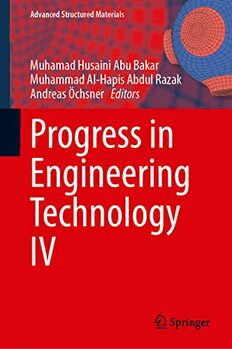
Progress in Engineering Technology IV PDF
Preview Progress in Engineering Technology IV
Advanced Structured Materials Muhamad Husaini Abu Bakar Muhammad Al-Hapis Abdul Razak Andreas Öchsner Editors Progress in Engineering Technology IV Advanced Structured Materials Volume 169 SeriesEditors AndreasÖchsner,FacultyofMechanicalEngineering,EsslingenUniversityof AppliedSciences,Esslingen,Germany LucasF.M.daSilva,DepartmentofMechanicalEngineering,Facultyof Engineering,UniversityofPorto,Porto,Portugal HolmAltenbach ,FacultyofMechanicalEngineering,OttovonGuericke UniversityMagdeburg,Magdeburg,Sachsen-Anhalt,Germany Common engineering materials reach in many applications their limits and new developments are required to fulfil increasing demands on engineering materials. Theperformanceofmaterialscanbeincreasedbycombiningdifferentmaterialsto achieve better properties than a single constituent or by shaping the material or constituents in a specific structure. The interaction between material and structure mayariseondifferentlengthscales,suchasmicro-,meso-ormacroscale,andoffers possibleapplicationsinquitediversefields. Thisbookseriesaddressesthefundamentalrelationshipbetweenmaterialsandtheir structureontheoverallproperties(e.g.mechanical,thermal,chemicalormagnetic etc.)andapplications. ThetopicsofAdvancedStructuredMaterialsincludebutarenotlimitedto (cid:129) classical fibre-reinforced composites (e.g. glass, carbon or Aramid reinforced plastics) (cid:129) metalmatrixcomposites(MMCs) (cid:129) microporouscomposites (cid:129) microchannelmaterials (cid:129) multilayeredmaterials (cid:129) cellular materials (e.g., metallic or polymer foams, sponges, hollow sphere structures) (cid:129) porousmaterials (cid:129) trussstructures (cid:129) nanocompositematerials (cid:129) biomaterials (cid:129) nanoporousmetals (cid:129) concrete (cid:129) coatedmaterials (cid:129) smartmaterials AdvancedStructuredMaterialsisindexedinGoogleScholarandScopus. Moreinformationaboutthisseriesathttps://link.springer.com/bookseries/8611 · Muhamad Husaini Abu Bakar · Muhammad Al-Hapis Abdul Razak Andreas Öchsner Editors Progress in Engineering Technology IV Editors MuhamadHusainiAbuBakar MuhammadAl-HapisAbdulRazak MalaysianSpanishInstitute MalaysianSpanishInstitute UniversitiKualaLumpur UniversitiKualaLumpur Kulim,Kedah,Malaysia Kulim,Kedah,Malaysia AndreasÖchsner FacultyofMechanicalEngineering EsslingenUniversityofAppliedSciences EsslingenamNeckar,Baden-Württemberg, Germany ISSN1869-8433 ISSN1869-8441 (electronic) AdvancedStructuredMaterials ISBN978-3-030-93249-7 ISBN978-3-030-93250-3 (eBook) https://doi.org/10.1007/978-3-030-93250-3 ©TheEditor(s)(ifapplicable)andTheAuthor(s),underexclusivelicensetoSpringerNature SwitzerlandAG2022 Thisworkissubjecttocopyright.AllrightsaresolelyandexclusivelylicensedbythePublisher,whether thewholeorpartofthematerialisconcerned,specificallytherightsoftranslation,reprinting,reuse ofillustrations,recitation,broadcasting,reproductiononmicrofilmsorinanyotherphysicalway,and transmissionorinformationstorageandretrieval,electronicadaptation,computersoftware,orbysimilar ordissimilarmethodologynowknownorhereafterdeveloped. Theuseofgeneraldescriptivenames,registerednames,trademarks,servicemarks,etc.inthispublication doesnotimply,evenintheabsenceofaspecificstatement,thatsuchnamesareexemptfromtherelevant protectivelawsandregulationsandthereforefreeforgeneraluse. Thepublisher,theauthorsandtheeditorsaresafetoassumethattheadviceandinformationinthisbook arebelievedtobetrueandaccurateatthedateofpublication.Neitherthepublishernortheauthorsor theeditorsgiveawarranty,expressedorimplied,withrespecttothematerialcontainedhereinorforany errorsoromissionsthatmayhavebeenmade.Thepublisherremainsneutralwithregardtojurisdictional claimsinpublishedmapsandinstitutionalaffiliations. ThisSpringerimprintispublishedbytheregisteredcompanySpringerNatureSwitzerlandAG Theregisteredcompanyaddressis:Gewerbestrasse11,6330Cham,Switzerland Preface Thevolumecontainsacollectionofpeer-reviewedpapersfromthe2020Conference onMultidisciplinaryEngineeringandTechnology(COMET2020),heldviaanonline platform,whichtookplaceinUniversitiKualaLumpur,MalaysianSpanishInstitute (UniKLMSI),Kedah,Malaysia,onDecember15–16,2020.ProgressinEngineering Technology IV contains twenty-five papers written by researchers participating in theconference.Topicscoveredinthisvolumeincludingenergyharvester,thermody- namics, vibration, dynamic of mechanics, manufacturing process, computer-aided manufacturing (CAM), CFD analysis, electronics, and microcontroller. Most of the topics are commonly encountered in industries and become an interest in the academic world. The learning of engineering technology curricular across univer- sities are now essential topics covered in various higher learning institutions in MalaysiaingeneralandinUniversitiKualaLumpur(UniKL)specifically.Itishoped thatthisvolumewillserveasanexcellentreferenceworkforresearchersandgraduate studentsworkingwith/onmultidisciplinaryengineeringtechnology. Kulim,Malaysia MuhamadHusainiAbuBakar Kulim,Malaysia MuhammadAl-HapisAbdulRazak EsslingenamNeckar,Germany AndreasÖchsner v Contents 1 BrakeSquealAnalysisandOptimizationUsingtheFinite ElementMethodandTaguchiTechniques ....................... 1 AdibKamarudin, AhmadRazleeAbKadir, ZainalNazriMohdYusuf,MuhammadAl’HapisAbdulRazak, T.A.A.Razak,andM.N.Ahmad 1.1 Introduction ............................................. 2 1.2 Methodology ............................................ 3 1.2.1 3DDesigniftheBrakeDiscModel .................. 4 1.2.2 FiniteElementAnalysis ........................... 5 1.2.3 ModalAnalysis ................................... 5 1.3 ResultandDiscussion ..................................... 6 1.3.1 NaturalFrequencyUsingMildSteel,GrayCast Iron,andCarbonCeramic .......................... 7 1.3.2 Comparison Natural Frequency Between All ThreeDesignandMaterials ........................ 8 1.3.3 TaguchiMethodUsingMinitab ..................... 11 1.4 Conclusion .............................................. 13 References .................................................... 13 2 Potential Experimental Analysis of Electrical Discharge MachineProcessParametersonStainlessSteelANSI304 ......... 15 AfnanNizarifAhmadZamzuri, MuhammadAl’HapisAbdulRazak, AznizamAbdullah, AhmadRazleeAbKadir, AhmadMajdiAbdul-Rani, FarooqI.Azam,andHaizumAimiZaharin 2.1 Introduction ............................................. 16 2.2 Literature ............................................... 16 2.2.1 ElectricalDischargeMachining ..................... 16 2.2.2 Die-Sinking ...................................... 17 2.2.3 WireEDMProcess ................................ 17 2.2.4 DielectricFluid ................................... 17 vii viii Contents 2.2.5 EDMMachineComponents ........................ 18 2.2.6 MaterialRemovalRate ............................ 18 2.2.7 SurfaceQualityAnalysis ........................... 18 2.2.8 TaguchiMethod .................................. 19 2.3 Methodology ............................................ 20 2.3.1 ResearchStructure ................................ 20 2.3.2 ExperimentalSetup ............................... 20 2.3.3 SelectionoftheWorkpiece ......................... 21 2.3.4 ToolDesign ...................................... 21 2.3.5 MechanismandMeasurementoftheMRR ........... 21 2.3.6 MechanismandEvaluationofSurfaceRoughness ..... 21 2.3.7 DesignofExperimentsAnalysis .................... 22 2.4 Conclusions ............................................. 22 References .................................................... 22 3 EmbeddedSystemUsingaPICMicrocontrollerforSeries Motor Four Quadrants Drive DC Chopper Controllers fortheApplicationinElectricalVehicles ........................ 23 SaharulArof, NorramleeMohamedNoor, PhilipMawby, HamzahArof,andEmiliaNoorsal 3.1 Introduction ............................................. 24 3.2 LiteratureReview ........................................ 24 3.3 Methodology ............................................ 26 3.3.1 EmbeddedSystemofFQDCControllers ............. 26 3.3.2 Detailed Operation Function on Each oftheControllers ................................. 28 3.3.3 SimulationSoftwareandExperimentalSetup forSimulationandExperiment ..................... 33 3.4 Results ................................................. 34 3.5 Conclusion .............................................. 35 References .................................................... 35 4 Pre-weldHeatingTemperatureEffectontheWeldingQuality ofa100TTruckCrackFrame—CaseStudy ..................... 39 Tumianto,MuhammadAl’HapisAbdulRazak,AzmiHassan, IwanSusanto, SuryaAtmadyaya, MohdRiduanIbrahim, andAsmawiIsmail 4.1 Introduction ............................................. 40 4.2 Methodologies ........................................... 40 4.2.1 DataCollectionMethod ........................... 41 4.2.2 DataAnalysis .................................... 41 4.3 Discussion .............................................. 42 4.3.1 TaguchiAnalysis ................................. 42 4.4 Conclusions ............................................. 44 References .................................................... 45 Contents ix 5 FeaturesExtractionfromaSecond-OrderBlackBoxModel MatchedtotheVeltinkModelforaSystemIdentification of Knee Extension for Control Law and Formulations ofClose-LoopControllerRehabilitationUsingFunctional ElectricalStimulation ......................................... 47 SaharulArof, EmiliaNoorsal, SaifulZaimyYahaya, NorHaslinaIbrahim,andHamzahArof 5.1 Introduction ............................................. 48 5.2 Literature ............................................... 48 5.3 Methodology ............................................ 49 5.3.1 Second-OrderBlackBoxModelSystem ............. 51 5.3.2 Second-OrderSystemFeaturesExtraction ............ 53 5.3.3 Simulation Model Using Matlab/Simulink Function ......................................... 55 5.4 ResultandDiscussion ..................................... 55 5.5 Conclusions ............................................. 62 References .................................................... 62 6 Analysis of an Adjustable Topside Mechanic’s Creeper forAutomotiveRepairandMaintenanceUsingSimulation Methods ...................................................... 65 SitiRohanaAhmad, SyasyaAqilahMohamadNadzri, andMuhammadZunnurrinGhazali 6.1 Introduction ............................................. 66 6.2 Literature ............................................... 66 6.3 Methodology ............................................ 67 6.3.1 DesignProcess ................................... 67 6.3.2 DesignofFoldableTopsideMechanic’sCreeper ...... 68 6.3.3 SimulationAnalysis ............................... 70 6.4 ResultsandDiscussion .................................... 71 6.4.1 SimulationResultsandDiscussion .................. 71 6.5 Conclusions ............................................. 76 References .................................................... 76 7 PotentialUseofaVibrationEnergyHarvesterinVehicles UsingaLinearMotionElectromagneticSuspensionSystem ....... 77 FazidahSaadandMuhammadNajibAbdulHamid 7.1 Introduction ............................................. 77 7.2 LinearElectromagneticEnergyHarvestingintheVehicle SuspensionSystem ....................................... 79 7.2.1 ElectromagneticRegenerativeShockAbsorber ........ 80 7.2.2 TubularLinearElectromagneticTransducers .......... 82 7.2.3 Electromagnetic Linear Vibration Energy HarvesterwithFerrofluidasaLubricant .............. 83 7.2.4 HybridRegenerativeShockAbsorber ................ 86 7.3 Discussion .............................................. 87 x Contents 7.4 Conclusion .............................................. 88 References .................................................... 88 8 PerformanceAnalysisofaCoatedPorousMediumBurner forCogeneration .............................................. 91 AhmadKamalIsmail, MohdZulkiflyAbdullah, NorHaslinaIbrahim, KhairulAkmalShamsuddin, andAyubAhmedJanvekar 8.1 Introduction ............................................. 92 8.2 Literature ............................................... 92 8.3 Methodology ............................................ 93 8.4 ResultsandDiscussion .................................... 94 8.5 Conclusions ............................................. 97 References .................................................... 97 9 ChildSafetyinCarCrashes:AModelingApproachforSafety SystemImprovements ......................................... 99 ShahrizanYusoff, NurulSyasyaFakhira, andNorHanizaBakhtiarJemily 9.1 Introduction ............................................. 99 9.2 Literature ............................................... 100 9.2.1 Application of Child Booster Seat toPrevent ChildInjuries .................................... 101 9.2.2 CategorizationofChildCarSeats ................... 103 9.3 Methodology ............................................ 103 9.4 ResultsandDiscussion .................................... 104 9.5 Conclusion .............................................. 107 References .................................................... 108 10 ModellingofAir-GapMagneticFluxDensityDistribution forSurface-MountedPermanentMagnetSynchronousMotor UsingtheAnalyticalSub-DomainMethod ....................... 109 M.Rezal,D.Ishak,andM.S.Ahmad 10.1 Introduction ............................................. 109 10.2 LiteratureReview ........................................ 110 10.2.1 Sub-DomainMethod .............................. 110 10.2.2 AirgapFluxDensityforSlotlessPMSM ............. 112 10.3 Methodology ............................................ 113 10.3.1 MotorParametersand2-DDesign ................... 113 10.3.2 AirgapFluxDensityforSlotlessPMSM ............. 113 10.4 ResultsandDiscussion .................................... 115 10.5 Conclusion .............................................. 116 References .................................................... 118
